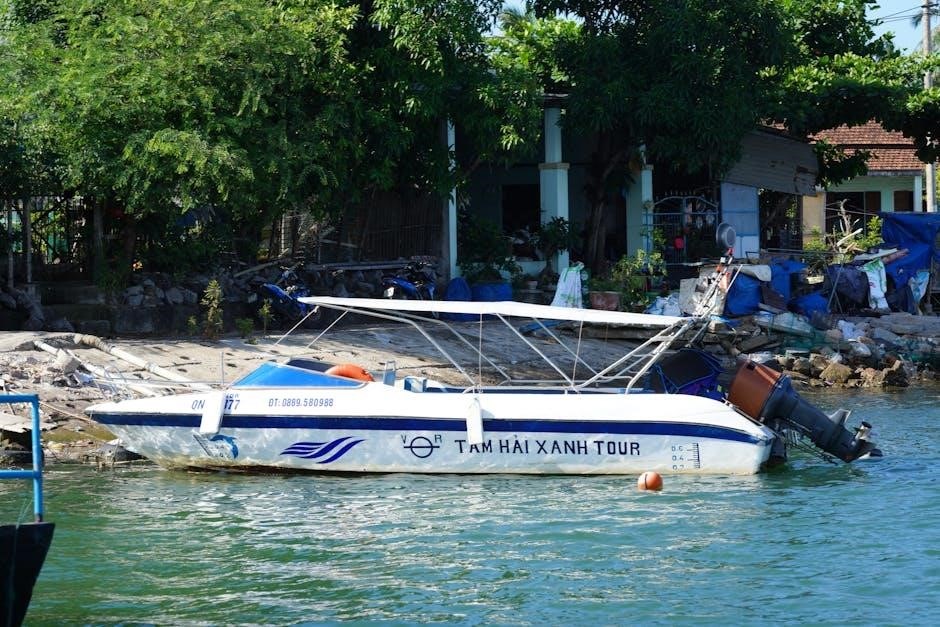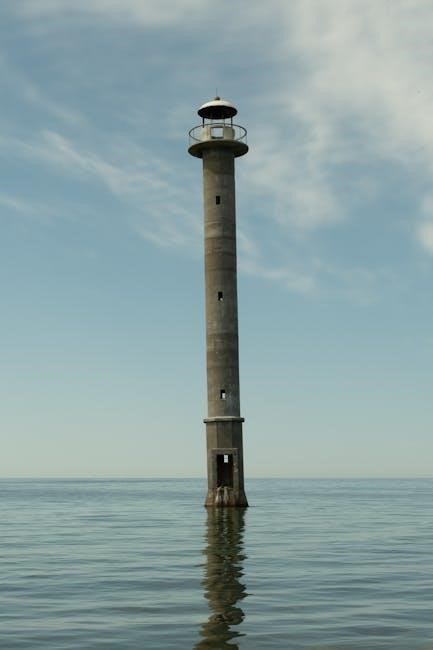
Welcome to the Johnson Propeller Guide, your comprehensive resource for selecting and understanding propellers. This guide helps you optimize boat performance, covering materials, maintenance, and more.
1.1 Overview of Johnson Propellers
Johnson propellers are renowned for their durability and performance, available in aluminum and stainless steel. Designed for Evinrude/Johnson outboard motors, they cater to various boating needs. The propellers are engineered to enhance speed, acceleration, and fuel efficiency. Whether for fishing or recreational use, Johnson propellers are tailored to specific engine horsepower and water conditions. With options like 10 spline and 14 spline shafts, they ensure compatibility and optimal functionality. Proper selection is crucial for maximizing boat performance, making Johnson propellers a trusted choice among boating enthusiasts. This guide helps users make informed decisions for their unique requirements.
1.2 Importance of Proper Propeller Selection
Proper propeller selection is vital for maximizing boat performance, efficiency, and safety. A well-matched propeller ensures optimal engine RPM, top speed, and fuel economy. Incorrect selection can lead to reduced performance, increased fuel consumption, and potential engine damage. Factors such as boat size, load, and water conditions must be considered. Johnson propellers are designed to meet specific needs, making precise selection crucial. This guide provides tools and insights to help boaters choose the right propeller for their Evinrude/Johnson outboard, ensuring enhanced boating experiences and protecting their investment.

Understanding Propeller Basics
Propellers are essential for boat propulsion, converting engine power into thrust. They consist of blades attached to a hub, with types varying in material and design.
2.1 Types of Propellers (Aluminum vs. Stainless Steel)
Propellers are available in two primary materials: aluminum and stainless steel. Aluminum propellers are cost-effective, lightweight, and offer good performance for smaller boats. They are also easier to repair. Stainless steel propellers, while more expensive, provide superior durability, corrosion resistance, and performance at higher speeds. They are ideal for larger boats and heavy-duty applications. The choice between aluminum and stainless steel depends on your boat’s size, engine power, and intended use. Both materials are widely used and offer distinct advantages for different boating needs.

2.2 Key Propeller Terminology (Pitch, Diameter, Blades)
Pitch refers to the distance a propeller travels in one full rotation, measured in inches. A higher pitch increases speed but may reduce acceleration. Diameter is the total width of the propeller from tip to tip, affecting how much water it displaces. Blades are the number of spinning arms; more blades enhance stability and smooth operation at higher speeds. Understanding these terms is crucial for selecting the right propeller for your boat’s performance needs, ensuring optimal efficiency and handling in various water conditions.
2.3 How Propeller Design Impacts Boat Performance
Propeller design significantly influences a boat’s performance, affecting speed, acceleration, and efficiency. The pitch determines how much water the propeller moves with each rotation, impacting top speed and throttle response. A larger diameter displaces more water, enhancing stability but potentially reducing agility. The number of blades affects smoothness and vibration, with more blades often improving stability at higher speeds. Proper design ensures optimal engine RPM, fuel efficiency, and handling, making it critical to match the propeller to the boat’s intended use and operating conditions for peak performance and reduced wear on the engine and drivetrain.

Propeller Materials and Construction
Propellers are crafted from durable materials like aluminum or stainless steel, each offering unique benefits. Aluminum propellers are lightweight and cost-effective, while stainless steel provides strength and durability. Hub kits ensure smooth operation, connecting the propeller to the engine. Together, these components enhance performance, efficiency, and longevity, making them essential for optimal boating experiences.
3.1 Aluminum Propellers: Benefits and Drawbacks
Aluminum propellers are a popular choice for their affordability and lightweight design, enhancing acceleration and fuel efficiency. They are ideal for smaller boats and casual use due to their lower cost and ease of repair. However, aluminum propellers are less durable than stainless steel, prone to damage from debris, and may bend under stress. While they offer excellent performance at lower speeds, they can be less efficient at higher speeds. Despite these drawbacks, aluminum propellers remain a practical option for many boaters seeking a cost-effective solution without compromising basic functionality.
3.2 Stainless Steel Propellers: Advantages and Considerations
Stainless steel propellers offer superior durability and performance, making them a top choice for boaters seeking long-term reliability. Their resistance to corrosion and ability to withstand heavy use in harsh conditions set them apart from aluminum models. Stainless steel props maintain their shape under stress, ensuring consistent performance and better efficiency at higher speeds. However, they are heavier and more expensive upfront. Despite the higher cost, their longevity and enhanced performance make them a worthwhile investment for those prioritizing durability and optimal boat handling in demanding water conditions.
3.3 Hub Kits and Their Role in Propeller Functionality
Hub kits are essential components that connect the propeller to the engine shaft, ensuring proper alignment and functionality. They typically include a splined bushing that fits securely onto the shaft, allowing the propeller to rotate smoothly. Hub kits are designed to absorb stress and vibrations, protecting both the propeller and engine. Proper installation and compatibility are crucial for optimal performance. The hub kit must match the engine’s horsepower and usage conditions to ensure efficient power transfer and minimize wear. Regular inspection and maintenance of hub kits are vital to maintain peak propeller functionality and overall boat performance.

Propeller Selection Guide
This section provides a detailed guide to selecting the ideal propeller for your engine, ensuring optimal performance, efficiency, and compatibility with your boat’s specific needs.
4.1 How to Choose the Right Propeller for Your Engine
Selecting the right propeller involves considering engine horsepower, boat usage, and water conditions. Choose between aluminum or stainless steel based on durability and performance needs. Use propeller selection charts to match your outboard motor specifications for optimal efficiency and speed. Proper fitment ensures maximum performance and prevents engine damage, while testing different propellers can refine your setup for peak performance.
4.2 Factors Affecting Propeller Performance (Speed, Load, Water Conditions)
Propeller performance is influenced by speed, load, and water conditions. Higher speeds require precise pitch for efficiency, while heavy loads demand durability. Water conditions, such as choppy or calm, affect propeller choice, with stainless steel often preferred in rough waters. Proper selection ensures optimal boat performance, balancing speed and fuel economy. Testing under varying conditions helps refine propeller choice for peak efficiency and handling, ensuring your boat operates smoothly in all scenarios.
4.3 Using Propeller Selection Tools and Charts
Propeller selection tools and charts simplify the process of choosing the right propeller for your engine. These resources allow you to input specific details like horsepower, year, and boat type to narrow down options. Charts often include recommendations based on boat length, load, and water conditions. Tools like the Quicksilver Propeller Guide and Propeller Depot’s selector help ensure compatibility and performance. By cross-referencing these tools, you can identify the ideal propeller for your needs, optimizing speed, efficiency, and overall boat performance. Always consult manufacturer charts for precise fitment and reliability.

Johnson Propeller Compatibility
Johnson propeller compatibility ensures optimal performance by matching propellers to your engine’s horsepower and boat type. Materials like aluminum and stainless steel cater to durability and cost needs. Proper fitment, including spline shafts, guarantees smooth operation and maximizes efficiency for your outboard motor.
5.1 Matching Propellers to Engine Horsepower
Matching the propeller to your engine’s horsepower ensures optimal performance and efficiency. Proper alignment with your outboard motor’s specifications maximizes speed and fuel economy. Always select a propeller that fits your engine’s horsepower range, considering factors like RPM, boat load, and water conditions. Using the Johnson Propeller Guide, you can narrow down options to find the ideal fit for your outboard motor. This ensures smooth operation, reduced wear, and enhanced overall boating experience. Incorrect matching can lead to poor performance or engine strain, making accurate selection crucial for longevity and satisfaction.
5.2 Propeller Fitment for Evinrude/Johnson Outboard Motors
Proper propeller fitment is crucial for Evinrude and Johnson outboard motors to ensure optimal performance and longevity. Always match the propeller to the motor’s specifications, including horsepower, RPM, and shaft type. For Evinrude/Johnson motors, consider spline shaft compatibility—10 spline for smaller engines and 14 spline for larger models. Hub kits are essential for secure mounting and smooth operation. Use the Propeller Depot or Quicksilver guide to find the right fit. Incorrect fitment can lead to poor performance, reduced efficiency, or even engine damage, making accurate selection vital for your boating experience.
5.3 Understanding Spline Shafts (10 Spline vs. 14 Spline)
Spline shafts are critical for propeller compatibility, with Evinrude/Johnson motors using either 10 spline or 14 spline configurations. The 10 spline shaft is typically found on smaller engines, while the 14 spline shaft is designed for larger, more powerful motors. Proper alignment and fitment are essential to ensure smooth operation and prevent damage. Using the wrong spline size can lead to poor performance or mechanical failure. Always verify the spline count when selecting a propeller for your Evinrude or Johnson outboard motor to maintain optimal functionality and longevity of your boating system.

Propeller Performance and Optimization
Optimizing propeller performance enhances speed, acceleration, and fuel efficiency. Proper blade design and pitch ensure maximum efficiency, while material choice impacts durability and overall boat handling capabilities effectively.
6.1 How Propeller Choice Affects Top Speed
Propeller choice significantly impacts a boat’s top speed, with differences of up to 5-10 MPH depending on the propeller’s design. Pitch, diameter, and blade count play critical roles. A higher pitch propeller generally increases top speed but may reduce acceleration. Conversely, a lower pitch enhances acceleration at the cost of lower maximum speed. Additionally, propellers with more blades provide better stability but can slightly reduce top speed. Selecting the right propeller ensures optimal performance, balancing speed, handling, and fuel efficiency for your specific boating needs and engine capabilities.
6.2 Impact on Acceleration and Handling
Propeller choice directly influences acceleration and handling, with lower pitch propellers delivering faster acceleration but lower top speeds. Higher pitch propellers may reduce acceleration but improve top-end performance. Blade count also plays a role, with more blades enhancing stability and smoothness at the cost of slightly reduced speed. Proper propeller selection ensures optimal acceleration and responsive handling, critical for maneuvers like cornering or towing. Balancing these factors is essential for achieving desired performance, whether for high-speed cruising or dynamic handling in various water conditions, ensuring your boat operates efficiently and responsively under different loads and scenarios.
6.3 Fuel Economy and Efficiency Considerations
Propeller selection significantly impacts fuel economy, as the right pitch and blade count optimize engine RPM for efficient operation. Lower pitch propellers often improve fuel efficiency at lower speeds but may struggle at higher speeds. Conversely, higher pitch propellers enhance efficiency at higher speeds but can reduce performance at lower RPM. Blade count also plays a role, with more blades typically improving efficiency but potentially reducing top speed. Ensuring your propeller aligns with your engine’s optimal RPM range is critical for maximizing fuel economy and overall performance, making it a key consideration for cost-conscious and environmentally aware boaters.

Maintenance and Care
Regular propeller maintenance ensures optimal performance and longevity; Clean propellers prevent damage, inspect for dings or bends, and store properly during off-season to maintain efficiency and safety.
7.1 Installing and Removing a Propeller
Installing a propeller requires careful alignment with the spline shaft. Secure it with the prop nut and tighten to specified torque. For removal, disconnect the battery and use a wrench to loosen the nut. Always refer to the engine manual for specific instructions to avoid damage or injury. Proper installation ensures optimal performance and safety, while incorrect methods can lead to costly repairs or accidents. Follow all safety precautions to maintain your propeller and engine in peak condition. Regular checks are essential for longevity and efficiency, ensuring your boat runs smoothly every time.
7.2 Cleaning and Inspecting Propellers
Regular cleaning and inspection of propellers are crucial for maintaining performance and longevity. Disconnect the battery before starting. Use a soft brush to remove debris and marine growth. Inspect for dings, bends, or corrosion, addressing issues promptly. Avoid harsh chemicals, as they can damage materials. Check hubs and splines for wear or damage. Proper maintenance prevents performance loss and ensures safety. Always follow manufacturer guidelines for cleaning and inspection to keep your propeller in optimal condition and extend its lifespan. Regular checks help identify potential problems early, saving time and money in the long run.
7.3 Troubleshooting Common Propeller Issues
Identifying and addressing propeller issues is key to maintaining optimal boat performance. Common problems include vibration, poor acceleration, or reduced speed. Inspect for damage, dings, or bent blades, which can cause imbalance. Check the hub and spline shaft for wear or misalignment. Ensure the propeller is properly secured and aligned with the engine. If issues persist, consult a propeller selection guide or seek professional advice. Regular maintenance and inspections can prevent costly repairs and ensure smooth operation. Addressing problems early helps maintain efficiency and extends the propeller’s lifespan.

Additional Resources
Explore the Quicksilver Propeller Guide, Propeller Depot, and online tools for detailed propeller selection. These resources offer charts, compatibility guides, and expert advice for optimal performance.
8.1 Quicksilver Propeller Guide
The Quicksilver Propeller Guide is a valuable resource for boaters, offering detailed charts and compatibility information to help select the right propeller for your engine. It provides insights into aluminum and stainless steel options, ensuring optimal performance. The guide also includes tools for calculating pitch, diameter, and blade count based on your boat’s specific needs. Additionally, Quicksilver’s online tools allow users to generate custom propeller recommendations, making the selection process seamless. This guide is a must-have for anyone looking to enhance their boat’s efficiency and overall performance on the water.
8.2 Propeller Depot and Other Suppliers

Propeller Depot is a trusted supplier offering high-quality aluminum and stainless steel propellers for various boat models. They provide a wide range of options, including Michigan Wheel propellers, to ensure compatibility with Evinrude/Johnson outboards. The Prop Shop also stocks propellers ready for immediate shipping or pickup, catering to different horsepower and spline requirements. Whether you need a 10-spline or 14-spline shaft, these suppliers have options available. They also offer hub kits and components, making them a one-stop solution for propeller needs. Their inventory includes popular models like the 9 X 9 and 9 X 10, ensuring optimal performance for your boat.
8.3 Online Tools for Propeller Selection
Online tools simplify propeller selection by allowing users to input specific details like horsepower and engine model year. Resources like the Quicksilver Propeller Guide and Propeller Depot offer detailed charts and part number searches. These tools help narrow down options, ensuring compatibility and optimal performance. Users can easily find propellers for Evinrude/Johnson outboards by filtering through materials and spline types. Additionally, features like listing all propellers or searching by part number provide flexibility for specific needs, making the selection process efficient and user-friendly.